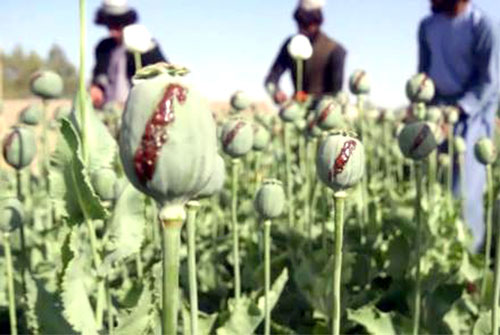The Afghanistan Analysts Network released a report predicting that the ban on the cultivation of opium will have “wide-ranging consequences.”
The report considered the Islamic Emirate’s possible motives for banning opium and the similarities between the recent ban and the one which the Islamic Emirate implemented in 2000.
The cultivation of opium and export of opiates is hugely important for the Afghan economy as a whole and any implementation of the ban will have wide-ranging consequences, said Jelena Bjelica, co-director and analyst with the Afghanistan Analysts Network (AAN).
The Islamic Emirate earlier announced a nationwide ban on opium and narcotics.
The production of opiates – opium, morphine, and heroin – is “Afghanistan’s largest illicit economy activity,” according to the United Nations Office on Drugs and Crime (UNODC), the report noted.
The agency estimated that the gross value of the Afghan illicit opiate economy in 2021 was $1.8 billion to $2.7 billion, and the total value of opiates, it said, “including domestic consumption and exports, stood at between 9 to 14 per cent of Afghanistan’s GDP, exceeding the value of its officially recorded licit exports of goods and services (estimated at 9 per cent of GDP in 2020).”
The AAN said banning the cultivation of opium and the export of opiates would be another “grievous blow to the economy” as the country has already lost most of its other foreign income in the form of on and off-budget support, both civilian and military, since the Islamic Emirate swept into power.
The opiates industry supports the stability of the local currency, the afghani, and provides a much needed financial boost to the country as a whole, according to the AAN.
The AAN cites the UNODC report as saying that globally, in 2020, Afghanistan contributed some 85 per cent of global opium production, supplying about 80 per cent of all opiate users in the world and therefore, a ban fully implemented over the long-term would also have major consequences for the world.
According to the UNODC, the estimated 6,800 tons of opium harvested in 2021 was eight percent more than 2020, even though less land had been sown with poppy – 177,000 hectares in 2021, down 47,000 from 2020, a decrease of 21 per cent. “Production has exceeded 6,000 tons for an unprecedented fifth consecutive year,” UNODC said. “This amount of opium could be converted into some 270 to 320 tons of pure heroin.”
An interview conducted in late October 2021 by the AAN revealed that the farmers from Kandahar, Herat, Farah, Laghman and Balkh indicated that the price increase was an undisputed incentive for farmers to plant opium poppy again in the 2021/22 growing season.
“The Taliban have not announced a ban on the cultivation and trade of poppy so far, but the people know that they won’t forbid it, at least not this year,” said a farmer In Kandahar as cited in the report.
The AAN quoted a British expert on Afghanistan’s illicit drug economy, David Mansfield, who believes it is “very unlikely [the ban] will be enforced this season.”
The AAN suggested that it was likely only to be in the autumn as the farmers are deciding about planting.
“The Taliban’s 2000 ban on opium was made in an edict by then leader Mullah Muhammad Omar on 27 July 2000. According to David Mansfield, it was the Taliban’s sixth attempt at banning opium. At the time, then head of UNODC research unit Sandeep Chawla praised the ban as “one of the most remarkable successes ever,” but later clarified that “in drug control terms it was an unprecedented success, but in humanitarian terms a major disaster,” the report said.
Mansfield believes that the earlier ban was driven by the Islamic Emirate desire for international recognition and need for funds to assist a population affected by protracted droughts.
The AAN cited the UNDOC reports saying that opium cultivation has increased over the past two decades compared to the period before 2000.
“The similarities between the situation in Afghanistan today and conditions back in 2000 are striking: severe drought, few or no countries recognizing the Taliban government, sanctions, and a need for aid. The Taliban are again facing a demand to suppress opium production and export, but also the old demands as well: respect women’s rights and human rights, and stop supporting international jihadist organizations, al-Qaeda and others,” the report said.
The new Afghan government has also made it more difficult for drug users to find drugs, the AAN report said. “I can’t buy any drugs. The Taliban treat us badly. They don’t let us sleep anywhere. They burn our tents and beat us,” a drug user said as quoted in the report.
“I used to buy one small pack (about 6 grams) of opium, enough for two or three doses for 100 afghanis (about USD 1.30 based on the exchange rate before the takeover). Now, we buy it for 200 to 250 Afghanis (USD 2.27 to 2.80 based on the current exchange rate). A pack of chars (cannabis) used to cost 50 to 100 afghanis (USD 0.66 to 1.33). Now, it goes for 200 to 300 afghanis (USD 2.27 to 3.40). Everything is expensive now.”—Tolonews










